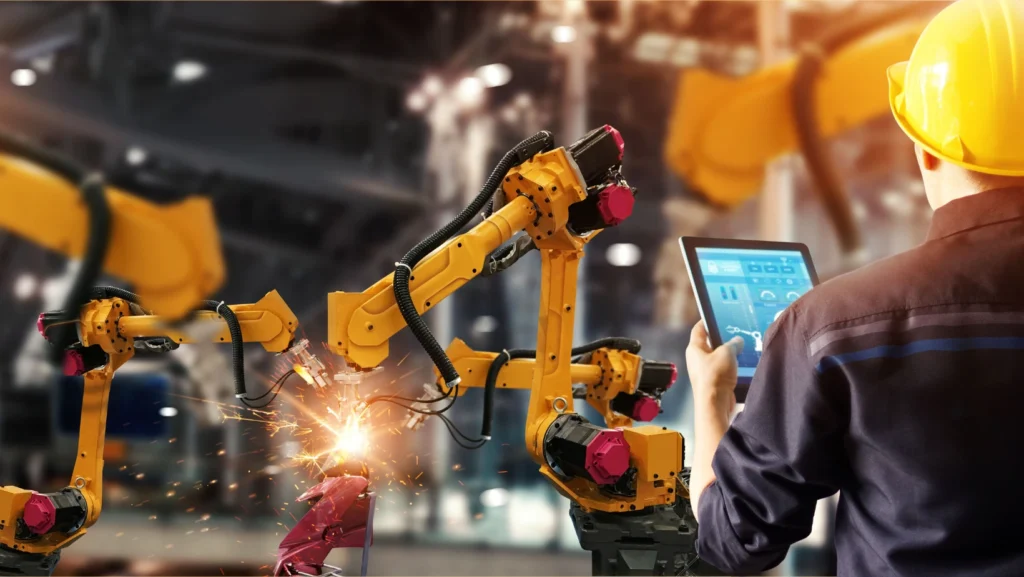The convergence of Industry 4.0 and the Internet of Things (IoT) is bringing about a revolutionary shift in the manufacturing industry that goes beyond the conventional production paradigms. Industry 4.0, sometimes referred to as the “fourth industrial revolution,” is a radical change in the way production operations are planned and carried out. The smooth incorporation of cutting-edge technology like artificial intelligence, data analytics, and the Internet of Things into the core of industrial operations characterizes this revolutionary period.
The combination of these technologies is revolutionizing manufacturing by taking it to a new level where intelligent decision-making, real-time data sharing, and networked systems come together to form highly flexible and effective production environments. Incorporating Industry 4.0 in manufacturing processes increases productivity by using sophisticated automation and data-driven decision-making.
The Internet of Things, a network of connected gadgets that can easily share and communicate data, is at the center of this revolutionary journey. When combined with Industry 4.0 concepts, the Internet of Things represents a strategic advancement toward the development of smart factories and networked supply chains, not just a technological advancement.
This mutually beneficial partnership has the potential to completely transform how companies handle supply chain and manufacturing, resulting in previously unheard-of levels of creativity, flexibility, and efficiency. We will delve into the complexities of this technological confluence as we explore IoT and Industry 4.0 and shed light on the doable actions that companies can take to harness this transformational force for a resilient and agile future.
What is Industry 4.0?

The term “industry 4.0,” or “fourth industrial revolution,” describes how the continuous incorporation of digital technologies is changing conventional manufacturing and industrial processes. The preceding industrial revolutions, which saw substantial improvements in manufacturing techniques, are built upon by this idea:
- The First Industrial Revolution: This occurred in the late 18th and early 19th centuries and was marked by the mechanization of industry through the use of steam and water power, which transformed rural cultures into industrialized ones.
- The Second Industrial Revolution: Was characterized by the development of assembly line production techniques and electricity in the late 19th and early 20th centuries.
- Third Industrial Revolution: Also called the Digital Revolution, it began in the late 20th century and is characterized by the automation and use of computers in production processes.
Industry 4.0 technology is a new age defined by the following salient characteristics:
- Interconnectivity: To link and communicate with different machines, systems, and devices, smart factories make use of the Internet of Things (IoT). This makes real-time data sharing and teamwork possible.
- Information Transparency: The production process is now more transparent because to the usage of sensors and sophisticated analytics. This facilitates process monitoring and optimization, maintenance demand prediction, and well-informed decision-making.
- Technical Support: By combining cutting-edge technologies like augmented reality, machine learning, and artificial intelligence (AI), workers can receive technical support that improves their ability to make decisions.
- Decentralized Decision-Making: Manufacturing processes can become more autonomous with the aid of AI and smart technologies, enabling decentralized decision-making and adaptive reactions to changing situations.
- Smart Products and Services: Digital capabilities can be added to products, and real-time service delivery opens up new revenue streams and business models.
- Cyber-Physical Systems: Cyber-physical systems are created when digital and physical processes are integrated. This entails monitoring and managing physical processes through the use of intelligent sensors, actuators, and communication technologies.
Industry 4.0 seeks to establish an industrial ecosystem that is more productive, adaptable, and responsive in order to spur innovation and growth in the manufacturing and associated industries. The integration of diverse technologies and a change in organizational and operational paradigms are integral to the continuous process of implementing Industry 4.0 concepts.
Benefits of Supply Chain in Industry 4.0
The revolutionary effect that Industry 4.0 is having on supply chain management is one of its main benefits. The old-fashioned linear supply chain is changing to become a dynamic web of connections. Improved supply chain visibility is made possible by real-time data interchange, from the procurement of raw materials to the final customer. Because of the increased visibility, decisions can be made with greater knowledge, which lowers the chance of disruptions and increases the supply chain’s overall resilience. The supply chain industry transformed through the use of cutting-edge technologies, improving visibility and efficiency throughout the logistics network.
Action Step: To obtain real-time insights into your supply chain operations, embrace supply chain digitization by putting in place reliable ERP systems and analytics tools.
How Industry 4.0 is Revolutionizing Manufacturing Operations?
Smart factories ‘a result of the implementation of Industry 4.0 principles’ have completely changed the way manufacturing is conducted. These factories use cutting-edge technologies to establish a productive, intelligent atmosphere. The cutting-edge iot development company is transforming business connections and intelligent solutions. Cyber-physical systems allow for autonomous decision-making by monitoring and managing physical processes. Increased production overall, decreased downtime, and enhanced efficiency are the outcomes.
Action Step: To improve the efficiency of your manufacturing operations, make an investment in automation technology like smart sensors and robotic process automation (RPA).
Impact of IoT on Manufacturing

An essential component of the Industry 4.0 transformation is the Internet of Things. Real-time data from machinery and equipment is collected and transmitted by Internet of Things devices, such as actuators and sensors. After then, this data is examined to estimate maintenance requirements, streamline procedures, and raise overall operational effectiveness. IoT improves quality assurance, resource management, and predictive maintenance in the industrial sector.
Action Step: Incorporate IoT devices thoughtfully into your production procedures to gather and examine information, allowing you to make informed decisions based on facts.
IoT Challenges and Industry 4.0
Despite the significant advantages of IoT in Industry 4.0, there are still difficulties. Significant obstacles include interoperability problems, security concerns, and the sheer amount of data collected. It is critical to ensure the security of IoT networks and devices since any weaknesses could result in operational disruptions and data breaches. The wide variety of IoT platforms and devices presents interoperability problems that need for standardized protocols to enable smooth integration.
Action Step: Set cybersecurity as a top priority and evaluate your IoT infrastructure thoroughly to find and fix any flaws.
Conclusion
In summary, Industry 4.0 automation is transforming the production and supply chain environment thanks to the Internet of Things. The sector is seeing previously unheard-of levels of efficiency, agility, and creativity thanks to the linked, intelligent systems. It takes a calculated approach to embrace this change, combining automation, data analytics, and IoT technologies. Through proactive measures such as digitizing industrial processes and improving supply chain visibility, companies may establish themselves as leaders in the industry 4.0 revolution.

